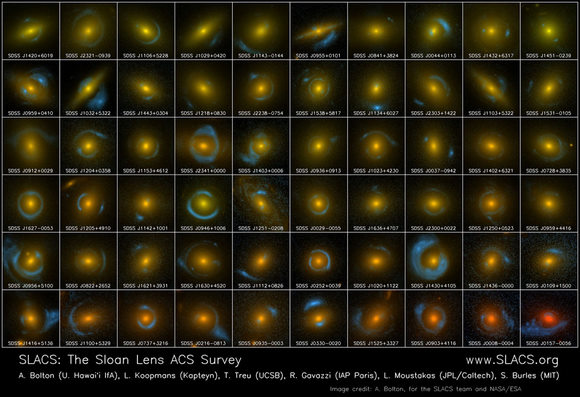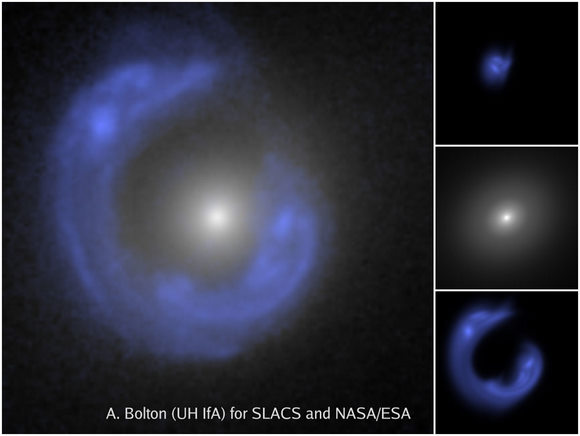[/caption]
An international team of astronomers have compiled the largest-ever single collection of “gravitational lens” galaxies, and their survey yielded information on the masses of galaxies, including an inference of the amount of dark matter. Gravitational lensing occurs when two galaxies happen to aligned with one another along our line of sight in the sky. The gravitational field of the nearer galaxy distorts the image of the more distant galaxy into multiple arc-shaped images. Sometimes this effect even creates a complete ring, known as an “Einstein Ring.” The findings of this survey helps settle a long standing debate over the relationship between and mass and luminosity in galaxies.
Using the Advanced Camera for Surveys on the Hubble Space Telescope to image galaxies that had been identified as gravitational lens galaxies by the Sloan Digital Sky Survey, the team was able to measure the distances to both galaxies in each “lensing” set, as well as measure the masses of each galaxy.
Gravitational lensing creates a “mirage” of a ring, and the Einstein ring images can be up to 30 times brighter than the image of the distant galaxy would be in the absence of the lensing effect. By combining Hubble and Sloan data into the Sloan Lens ACS (or SLACS) Survey, the team was able to make a mathematical model describing the lensing effect and use that model to illustrate what we would see if we could remove the lensing effect.
Animation of the lensing effect.
“The SLACS collection of lenses is especially powerful for science,†said Adam Bolton from the University of Hawaii, lead author of two papers describing these latest results. “For each lens, we measured the apparent sizes of the Einstein rings on the sky using the Hubble images, and we measured the distances to the two galaxies of the aligned pair using Sloan data. By combining these measurements, we were able to deduce the mass of the nearer galaxy.â€
By considering these galaxy masses along with measurements of their sizes, brightnesses, and stellar velocities, the SLACS astronomers were able to infer the presence of “dark matter†in addition to the visible stars within the galaxies. Dark matter is the mysterious, unseeable material that is the majority of matter in the universe. And with such a large number of lens galaxies across a range of masses, they found that the fraction of dark matter relative to stars increases systematically when going from galaxies of average mass to galaxies of high mass.

Albert Einstein predicted the existence of gravitational lenses in the 1930’s, but the first example was not discovered until the late 1970s. Since then, many more lenses have been discovered, but their scientific potential has been limited by the disparate assortment of known examples. The SLACS Survey has significantly changed this situation by discovering a single large and uniformly selected sample of strong lens galaxies. The SLACS collection promises to form the basis of many further scientific studies.
Original News Source: University of Hawaii


Now we just have to wait for some dolt to exclaim that dark matter doesn’t really exist and is just a theory, that our cosmology is flawed etc. etc, and the usual UT dark matter blog-comment fiasco can ensue…
Just wait until deep, fast all-sky deep, fast all-sky surveys commence (e.g. PAN-STARRS, etc.) in a few years combined with the next generation of space & huge ground-based obser vatories that will come online. The number & diversity of new gravitational lenses may be spectacular & informative to astronomers interested in Dark Matter and galaxy evolution in distant galaxies.
Whoa, there ‘fiend!
i’ve always followed your posts. Clearly you’re very passionate about this, but let’s not get too bogged down with it.
We both know D.E hasn’t been proven OR disproven to exist, but it doesn’t hurt to look at other models to explain unexpected phenomena.
Let’s see where the evidence takes us when it comes in…..
Dark Matter != Dark Energy
alphonso richardson Says:
July 23rd, 2008 at 2:12 am
Thanks mate. It was really intended as a cheeky post. A bit hard to convey that sense through written word only though!
I’m not anti-anygiventheory, I just take exception to the way in which some people put their point across. I agree with you though – science never got anywhere but through a wide open mind.